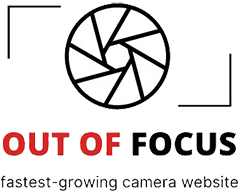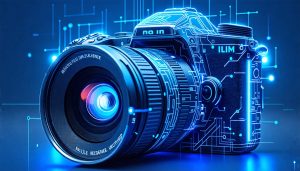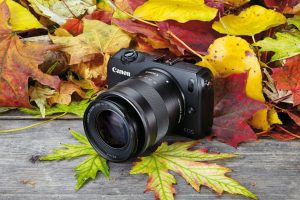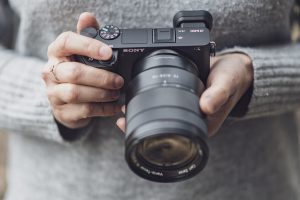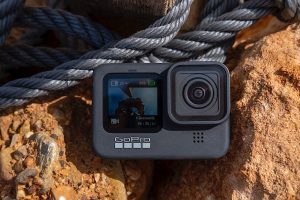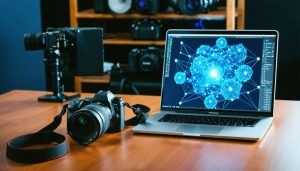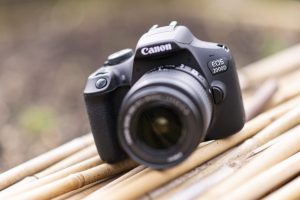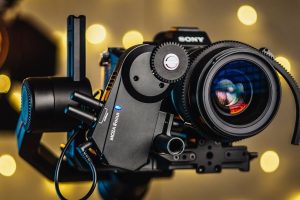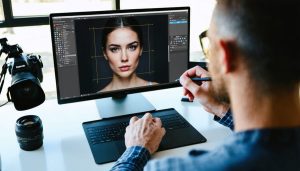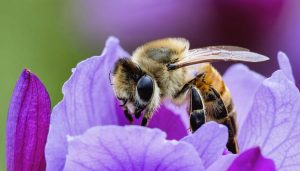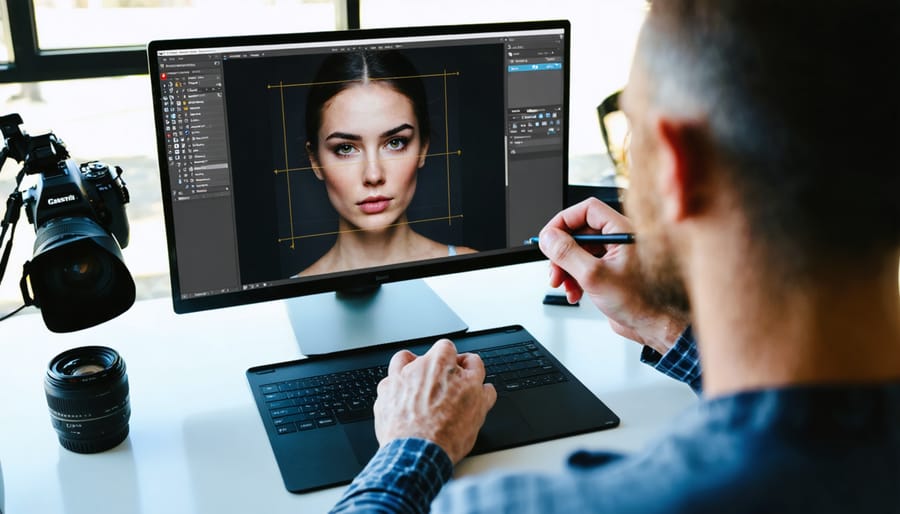
AI photo composition tools analyze your images in real-time, suggesting crop ratios, identifying distracting elements, and even predicting which arrangements will engage viewers most effectively. These algorithms have been trained on millions of professionally composed photographs, learning the mathematical patterns behind techniques like the rule of thirds, leading lines, and balanced negative space. The technology isn’t replacing your creative vision—it’s offering a second set of eyes that never gets tired during long editing sessions.
The practical reality is more nuanced than the marketing promises. Yes, AI can instantly identify a tilted horizon or suggest moving your subject slightly left for better balance. Adobe’s Sensei, Luminar’s composition analysis, and dedicated apps like Spectre AI deliver genuinely useful feedback, particularly when you’re stuck or working quickly. But these tools struggle with intentional rule-breaking, cultural context, and the emotional weight that makes certain “imperfect” compositions powerful.
The question isn’t whether AI composition tools work—they do—but when to trust them. Professional photographers report using these features most during client work with tight deadlines, while reverting to pure instinct for personal projects. The sweet spot appears to be treating AI suggestions as a starting point for evaluation rather than final verdicts. Understanding both the capabilities and limitations of these tools helps you decide which compositional decisions deserve the human override, and which benefit from algorithmic precision that catches what your eye might miss after hours behind the camera.
What AI Photo Composition Actually Means
Let’s clear up what we’re actually talking about when we say AI photo composition. Unlike the basic auto mode on your camera or those one-tap Instagram filters, AI composition tools use machine learning algorithms trained on millions of professionally composed images to understand what makes a photograph visually compelling.
Think of it this way: traditional auto modes simply adjust exposure and focus. Basic filters apply predetermined color adjustments. But AI photography composition tools actually analyze the elements within your frame—where your subject sits, how lines lead the eye, the balance of visual weight—and provide intelligent suggestions or adjustments based on established compositional principles.
Here’s a real-world example. Imagine you’re photographing a landscape with mountains and a lake. A traditional filter might enhance the blues and greens. An AI composition tool, however, recognizes that placing the horizon line according to the rule of thirds would strengthen the image, identifies a distracting branch in the corner that draws attention away from your focal point, and suggests cropping that creates better visual flow from foreground to background.
The technology works through neural networks that have been trained to recognize patterns in successful photographs. These systems don’t just follow rigid rules—they learn from contextual relationships. They understand that portrait composition differs from landscape composition, that architectural photography follows different principles than wildlife shots, and that sometimes breaking traditional rules creates more dynamic images.
The key distinction is intelligence versus automation. Your camera’s auto mode follows programmed instructions. AI composition tools make contextual decisions based on learned visual relationships. They’re analyzing your specific image and its unique elements, then applying sophisticated pattern recognition to suggest improvements that enhance how viewers naturally engage with photographs.
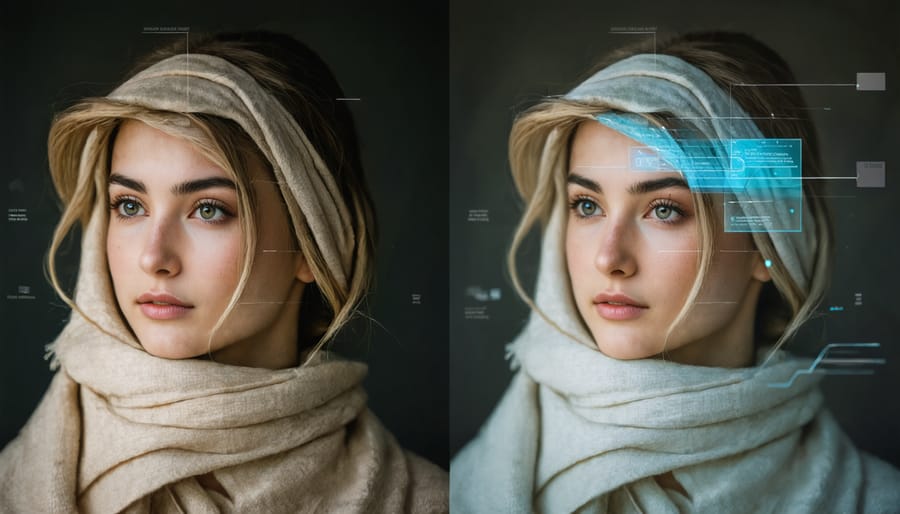
How AI Analyzes and Improves Your Compositions
Real-Time Composition Guidance
Modern cameras equipped with AI composition tools function like having a composition mentor looking over your shoulder. These systems analyze your frame in real-time, offering immediate guidance before you press the shutter button.
The most common form of real-time guidance appears as on-screen overlays directly in your viewfinder or LCD screen. Many mirrorless cameras now display visual cues like gridlines that automatically adjust based on scene analysis, or highlighted areas suggesting where to position your subject. For instance, if you’re photographing a person, the camera might display a subtle indicator showing the ideal placement according to the rule of thirds or golden ratio.
Beyond simple overlays, advanced systems provide active suggestions. Some cameras will gently vibrate or display a notification when they detect potential issues like a tilted horizon, cluttered background, or subjects positioned too close to the frame edge. Think of these as helpful nudges rather than rigid rules. Sony’s latest Alpha series, for example, can warn you when important elements are cut off at frame edges, while Canon’s newer models incorporate AI camera tricks that highlight distracting elements in busy scenes.
The beauty of real-time guidance is its educational value. You’re not just getting better shots immediately, you’re training your compositional eye. Over time, you’ll internalize these principles and rely less on the technology, though the safety net remains valuable when shooting in challenging or unfamiliar situations.
Post-Processing Composition Fixes
We’ve all been there—you’re reviewing your shots and realize the composition is slightly off. Maybe the horizon isn’t quite level, or you’ve left too much dead space on one side. Before AI, these mistakes meant either living with an imperfect image or spending considerable time manually correcting them in editing software.
AI-powered post-processing tools now offer a safety net for compositional mishaps. Adobe Photoshop’s Content-Aware Crop, for instance, uses AI to intelligently fill in areas when you straighten a crooked horizon, eliminating those annoying white corners that traditionally appear. The technology analyzes surrounding pixels and generates believable content to complete your frame.
Tools like Perfectly Clear and Luminar Neo take this further with automatic reframing suggestions. These programs analyze your image using the same compositional principles we discussed earlier—rule of thirds, leading lines, balance—and propose alternative crops that might strengthen your composition. In my testing, these suggestions proved surprisingly effective for salvaging vacation snapshots or quickly processing large batches of event photos.
The reframing capabilities shine particularly bright when adapting images for different aspect ratios. If you shot in 3:2 but need a square crop for Instagram, AI tools can identify the compositional focal points and suggest crops that maintain visual interest rather than simply center-cropping your subject.
However, these tools work best when you start with reasonably decent source material. AI can’t resurrect a fundamentally flawed composition or create interesting content where none exists. Think of these features as refinement tools rather than magic wands—they enhance good work but can’t replace thoughtful shooting.
Subject Recognition and Balance
Modern AI composition tools work like having a seasoned photographer looking over your shoulder, instantly analyzing your frame for what matters most. These systems use computer vision to detect faces, recognize objects, and identify key subjects within milliseconds. Think of it as pattern recognition on steroids—the AI scans your image, identifies elements like a person’s eyes, a mountain peak, or a car, then calculates their relative importance based on size, contrast, and context.
What makes this particularly useful is how AI handles visual weight distribution. Rather than just centering everything, these tools understand that a person’s face carries more visual weight than an empty sky, or that a brightly colored object draws attention differently than muted backgrounds. The software then suggests repositioning—perhaps nudging your subject slightly off-center for better rule-of-thirds alignment, or recommending a tighter crop to eliminate distracting elements competing for attention. Some advanced systems even predict where viewers’ eyes will naturally travel across your image, helping you arrange elements along that visual path for maximum impact.

The Best AI Composition Tools Working Today
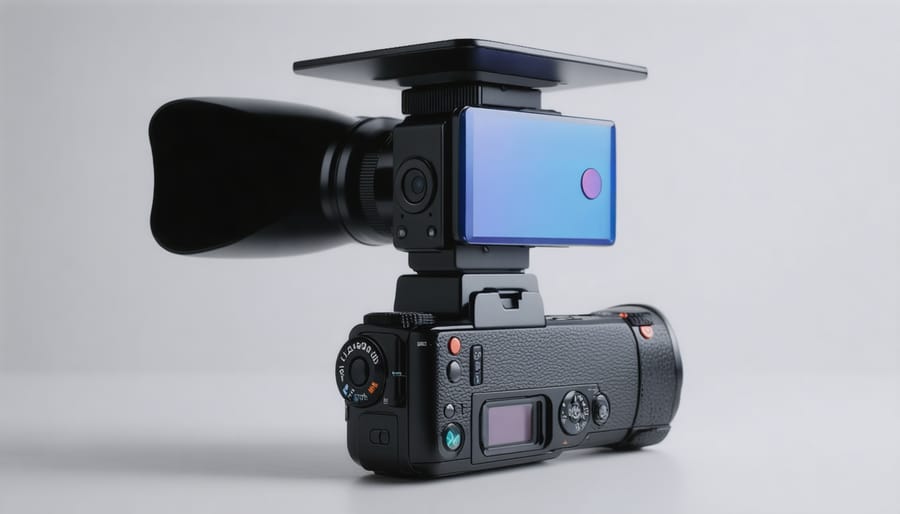
In-Camera AI Systems
Modern cameras are increasingly arriving with AI composition assistance baked right into their firmware, and the implementations vary significantly across manufacturers. If you’re considering upgrading your gear or wondering whether these features actually help in the field, here’s what you need to know from real-world use.
Sony’s latest Alpha series cameras include an AI-powered subject recognition system that tracks eyes, faces, animals, and even vehicles with remarkable accuracy. While primarily designed for autofocus, this technology also influences composition by helping you understand where the camera “sees” your subject. The a7 IV and a7R V models display these recognition zones in real-time, which subtly guides your framing decisions. In practice, watching the camera identify and prioritize subjects helps you become more intentional about placement within the frame.
Canon’s EOS R series takes a slightly different approach with their Subject Tracking feature combined with compositional guides. The R5 and R6 Mark II offer customizable overlay grids that work alongside AI detection to suggest balanced framing. During testing with wildlife photography, these systems proved particularly helpful when shooting fast-moving subjects, though they’re less transformative for carefully composed landscapes where you have time to think.
Nikon’s Z8 and Z9 flagship models include an Auto Area AF mode that uses deep learning to identify subjects and maintain focus, while their 3D Tracking monitors compositional balance. These cameras can recognize when a subject approaches frame edges and provide subtle indicators.
The honest assessment? These systems work best as training wheels for newer photographers or safety nets during fast-paced shooting. They won’t replace compositional knowledge but can prevent obvious mistakes when you’re focused on capturing fleeting moments.
Mobile Photography Apps
Your smartphone already packs serious AI composition assistance, and you don’t need expensive gear to tap into it. Both iOS and Android platforms now offer sophisticated apps that analyze your frame in real-time and suggest improvements before you even press the shutter.
For iOS users, Adobe Lightroom Mobile stands out with its built-in composition overlays and AI-powered cropping suggestions. I’ve watched it transform snapshots by recommending subtle reframing that emphasizes leading lines I’d initially missed. The app learns from professional photography databases, so its suggestions genuinely improve over time. ProCamera is another solid option, offering live composition guides that help you nail the rule of thirds without thinking about it.
Android photographers have equally powerful choices. Google Photos integrates seamlessly with your device’s native camera and uses AI to suggest crops that strengthen your composition after shooting. Snapseed, also by Google, provides intelligent perspective correction that’s particularly impressive for architectural photography where straight lines matter.
The real-world effectiveness? These tools work best when you’re learning. I’ve seen beginners dramatically improve their framing within weeks by following the suggestions, then gradually developing an intuitive sense for composition. The AI photography software essentially accelerates the learning curve that traditionally took years of practice.
However, these apps shine brightest in straightforward scenarios. Complex scenes with multiple subjects or unconventional compositions might confuse the algorithms, which still favor traditional compositional rules over creative experimentation.
Desktop Editing Software
The professional AI image editors you already use have quietly become composition powerhouses. Adobe Lightroom’s AI-powered cropping suggestions now analyze your images against compositional principles like the rule of thirds, golden ratio, and leading lines. When you click the crop tool, it offers multiple composition-optimized options instantly. I’ve found it particularly helpful when reviewing hundreds of shots from a wedding or event, where I might have missed better framing possibilities in the moment.
Photoshop’s Content-Aware Fill has evolved beyond simple object removal. The neural filters can now reposition elements while intelligently filling backgrounds, essentially letting you adjust composition after the fact. Moving a subject slightly off-center or removing distracting elements that break visual flow becomes remarkably seamless.
Luminar Neo takes this further with its AI Structure tool, which identifies and enhances compositional elements like leading lines and patterns you might not have noticed during shooting. Its Sky AI replacement feature isn’t just about dramatic skies, it’s about balancing the tonal weight in your frame’s upper third.
ON1 Photo RAW offers AI quick masks that recognize compositional zones, making it easier to apply selective adjustments that guide the viewer’s eye through your intended visual path. The Portrait AI specifically identifies and enhances focal points while softening peripheral elements.
These tools work best as refinement aids rather than compositional crutches. They’re excellent for salvaging shots with minor framing issues or discovering alternative compositions in images you’d otherwise overlook.

When AI Composition Helps (And When It Doesn’t)
Where AI Excels
AI composition tools really shine in certain photographic scenarios where established rules meet creative possibilities. Let’s explore where these digital assistants prove most valuable in real-world shooting situations.
Landscape photography benefits enormously from AI guidance, particularly when you’re working with complex scenes featuring multiple elements. Picture yourself at a coastal vista with rocks, waves, a lighthouse, and dramatic clouds. An AI tool can quickly suggest how to balance these components using the rule of thirds or leading lines, helping you decide whether to emphasize the foreground rocks or make the lighthouse your hero element. I’ve watched photographers cut their composition time in half during golden hour sessions, capturing multiple variations while the light remains perfect.
Portrait work presents another sweet spot for AI assistance. These tools excel at detecting faces and suggesting optimal positioning within the frame, ensuring proper headroom and eye-level placement. During event photography, where you’re moving quickly between candid moments and formal shots, AI can provide instant feedback on whether your subject placement feels natural or cramped. This proves especially helpful for newer photographers still developing their intuitive sense of spacing.
Event photography scenarios, from weddings to concerts, also benefit significantly. When you’re shooting fast-paced action, AI tools can analyze your frame in real-time, alerting you to distracting background elements or suggesting tighter crops. One wedding photographer I know uses AI guidance for reception shots, ensuring group photos maintain proper balance even when working with challenging room layouts and mixed lighting conditions.
Where Human Vision Still Wins
AI excels at recognizing patterns, but photography’s most memorable images often succeed precisely because they ignore conventional wisdom. This is where human vision maintains its irreplaceable edge.
Consider intentional rule-breaking. When a photographer deliberately places their subject in an awkward position to create tension, or uses negative space unconventionally to evoke loneliness, AI tools typically flag these as errors needing correction. The algorithm doesn’t understand your artistic intent. It can’t recognize that you’re channeling Dutch angle disorientation or deliberately creating visual discomfort for emotional impact.
Creative photography thrives on experimentation that defies logic. Street photographers like Saul Leiter made careers from partially obscured subjects and reflections that AI would probably rate poorly for “clarity” and “subject prominence.” Fashion and editorial work frequently embraces chaos, unexpected cropping, and compositional choices specifically designed to challenge viewers rather than comfort them.
Real-world example: A photographer shooting a series about urban isolation might center their subject in vast, empty architecture. AI composition tools would likely suggest tightening the frame or adding visual interest elsewhere. But that emptiness is the point—it’s the story itself.
AI also struggles with cultural and conceptual contexts. It can’t know you’re referencing a specific art movement, paying homage to another photographer’s style, or deliberately subverting expectations for a client’s avant-garde brand. These creative decisions require human judgment, cultural knowledge, and artistic vision that no algorithm can replicate. When your goal is innovation rather than perfection, trust your eye over the AI’s suggestions.
Integrating AI Composition Into Your Workflow
The key to successfully integrating AI composition tools is treating them as creative assistants rather than creative replacements. Think of AI composition analysis the way you might consider camera automation like autofocus—it handles technical grunt work so you can focus on vision and storytelling.
Start by using AI tools in your editing workflow rather than during shooting. This approach lets you learn what the AI considers strong composition without disrupting your in-the-moment creative process. Import your shots into Luminar Neo or Adobe Lightroom and see what compositional suggestions the AI offers. Compare its recommendations against your instincts. Where do they align? Where do they diverge? This reflective practice strengthens your own compositional eye.
For practical implementation, establish a 70-30 rule: rely on your trained eye for 70 percent of compositional decisions and use AI suggestions for the remaining 30 percent, particularly when you feel stuck or want a fresh perspective. Wedding photographer Sarah Chen explains her approach: “I shoot weddings entirely by instinct, but during culling, I’ll run my selects through AI composition analysis. Sometimes it highlights a frame I initially overlooked because the AI spotted balanced elements I missed in the heat of the moment.”
Avoid using AI composition as a real-time crutch that slows your shooting or makes you second-guess every frame. The best photographs often break compositional rules intentionally, something AI struggles to appreciate. Instead, use these tools for learning and occasional problem-solving. Review AI suggestions weekly, identify patterns in what it recommends, then internalize those principles. Over time, you’ll develop an enhanced compositional vocabulary that combines timeless fundamentals with data-driven insights.
The Controversy: Is AI Making Us Lazy Photographers?
The conversation around AI photo composition tools often feels like we’re reliving photography’s greatest hits of controversy. Remember when purists insisted autofocus would destroy true photography? Or when digital cameras were dismissed as toys for people who couldn’t handle film? Here we are again, and it’s worth examining both sides honestly.
The concerns aren’t completely unfounded. Some photographers worry that leaning too heavily on AI suggestions might atrophy our compositional instincts. If you’re constantly following AI prompts to “move left” or “adjust your angle,” are you actually learning why those adjustments improve your image? There’s a legitimate question about whether beginners who start with AI assistants might skip the foundational learning that comes from making mistakes and understanding compositional principles through trial and error.
I’ve spoken with photography educators who’ve noticed students sometimes struggle to explain why a composition works beyond “the AI said so.” That’s a red flag. Understanding the rule of thirds, leading lines, and negative space isn’t just academic knowledge—it’s what allows you to make intentional creative decisions rather than simply following suggestions.
However, the counterargument is equally compelling. Photography has always evolved through tools that make technical aspects easier, allowing photographers to focus more on creative vision. Light meters didn’t make us lazy about exposure; they freed us to think about storytelling. AI composition tools might follow the same trajectory.
Consider this: professional photographers aren’t abandoning their compositional knowledge when they use AI tools. Instead, they’re using them as second opinions or time-savers during high-pressure shoots. Wedding photographers have told me they appreciate the real-time feedback when they’re juggling a dozen responsibilities simultaneously. The AI doesn’t replace their expertise—it supplements it during moments when mental bandwidth is stretched thin.
The learning curve debate is particularly nuanced. Some educators now argue that AI tools can actually accelerate learning by providing immediate, contextualized feedback. Instead of reviewing your compositions hours later at home, you receive guidance in the moment when you can immediately apply corrections and understand the differences.
Think of AI composition tools as your most knowledgeable photography assistant—one that’s studied millions of images and can offer instant feedback, but one that doesn’t know your creative vision. These technologies excel at identifying technical imbalances, suggesting alternative crops, and even recognizing patterns you might have overlooked in the moment. But they can’t replace the intuition you’ve built through years of looking through a viewfinder, understanding light, or anticipating that perfect decisive moment.
The photographers seeing the best results are those who use AI as a springboard rather than a crutch. They’ve mastered the rule of thirds, understand leading lines, and know when to break compositional rules for impact. AI simply helps them work faster and explore variations they might not have considered.
As these tools continue evolving, we’ll likely see them become more context-aware, better understanding genre-specific compositional needs and even learning individual photographer preferences. The technology will improve, but your foundational knowledge will remain your greatest asset. Experiment freely with these tools, but keep sharpening your compositional eye. The best images will always come from the combination of human creativity and technological assistance, not one replacing the other.
